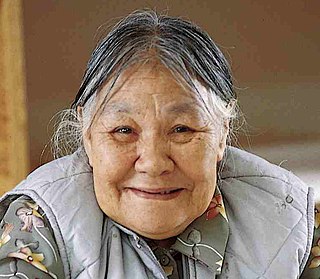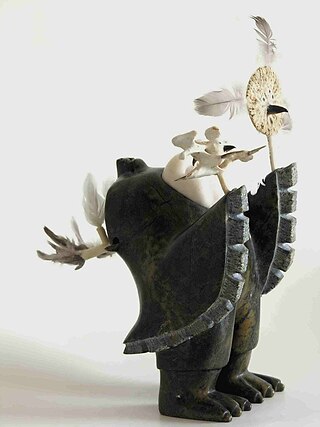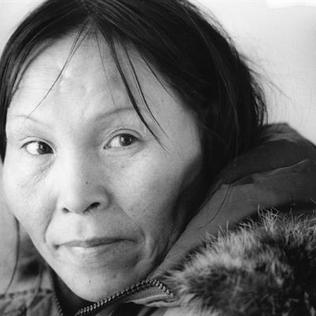
Jessie Oonark, was a prolific and influential Inuit artist of the Utkuhihalingmiut Utkuhiksalingmiut whose wall hangings, prints and drawings are in major collections including the National Gallery of Canada.

Kenojuak Ashevak,, is celebrated as a leading figure of modern Inuit art.

James Archibald Houston was a Canadian artist, designer, children's author and filmmaker who played an important role in the recognition of Inuit art and introduced printmaking to the Inuit. The Inuit named him Saumik, which means "the left-handed one".

Kinngait, formerly known as Cape Dorset until 27 February 2020, is an Inuit hamlet located on Dorset Island near Foxe Peninsula at the southern tip of Baffin Island in the Qikiqtaaluk Region of Nunavut, Canada.

Annie Pootoogook was a Canadian Inuk artist known for her pen and coloured pencil drawings. In her art, Pootoogook often portrayed the experiences of those in her community of Kinngait, in northern Canada, and memories and events from her own life.

Inuit art, also known as Eskimo art, refers to artwork produced by Inuit, that is, the people of the Arctic previously known as Eskimos, a term that is now often considered offensive. Historically, their preferred medium was walrus ivory, but since the establishment of southern markets for Inuit art in 1945, prints and figurative works carved in relatively soft stone such as soapstone, serpentinite, or argillite have also become popular.

Kananginak Pootoogook was an Inuk sculptor and printmaker who lived in Cape Dorset, Nunavut, in Canada. He died as a result of complications related to surgery for lung cancer.
Pitaloosie Saila was a Canadian Inuk graphic artist who predominantly made drawings and lithograph prints. Saila's work often explores themes such as family, shamanism, birds, and her personal life experiences as an Inuk woman. Her work has been displayed in over 150 exhibitions nationally and internationally, such as in the acclaimed Isumavut exhibition called "The Artistic Expression of Nine Cape Dorset Women". In 2004, Pitaloosie Saila and her well-known husband and sculptor Pauta Saila were both inducted into the Royal Canadian Academy of Arts.
Lucy Qinnuayuak (1915–1982) was an Inuit graphic artist and printmaker.

Napachie Pootoogook was a Canadian Inuit graphic artist.

Ulayu Pingwartok was a Canadian Inuk artist known for drawings of domestic scenes and nature.

Uqqurmiut Centre for Arts & Crafts is an arts centre that was established by the Uqqurmiut Inuit Artists Association in 1990, in Pangnirtung, in the Qikiqtaaluk Region of Nunavut, Canada. The Centre includes a Tapestry Studio, a Craft Gallery, and Print Shop. In spite of its remote location and small population, numerous Inuit from Pangnirtung have successfully marketed their prints, carvings, sculptures, and textile arts, such as woven wall hangings, to southern collectors. Starting in the 1970s, limited edition prints from the original Print Shop were published annually as the Pangnirtung Prints Collection through the then-Eskimo Co-operative. In 1970 a weaving studio was established and over time the tapestries attracted an international market.
Eleeshushe Parr was an Inuk graphic artist and sculptor, from the Kingnait area, who produced over 1,160 drawings. Her work has been exhibited in Canada, the United States, and Sweden.
Ikayukta Tunnillie was an Inuit artist in the fields of printmaking and drawing. Tunnillie was born in Nunavut and traveled for much of her life. Tunnillie's work in drawing and printmaking focused on animals and life in the North. She was one of the oldest printmakers to work with the West Baffin Eskimo Co-operative.
Elisapee Ishulutaq was a self-taught Inuit artist, specialising in drawing and printmaking. Ishulutaq participated in the rise of print and tapestry making in Pangnirtung and was a co-founder of the Uqqurmiut Centre for Arts & Crafts, which is both an economic and cultural mainstay in Pangnirtung. Ishulutaq was also a community elder in the town of Pangnirtung. Ishulutaq's work has been shown in numerous institutions, including the Marion Scott Gallery in Vancouver, the Winnipeg Art Gallery and the National Gallery of Canada.
Ohotaq (Oqutaq) Mikkigak was a Cape Dorset based Inuk artist from southern Baffin Island. Mikkigak was involved with Cape Dorset printmaking in the program's early years, providing drawn designs for printing. Many of his works were printed and featured in the studio's annual collections, including Eskimo Fox Trapper and three pieces used in the Cape Dorset Studio's 40th anniversary collection. Mikkigak's work has also been included in of over twenty group exhibitions and was the subject of multiple solo exhibitions, including a show held by Feheley Fine Arts called Ohotaq Mikkigak: Imagined Landscapes.
Innukjuakju Pudlat (1913–1972), alternatively known as Inukjurakju, Innukjuakjuk, Inujurakju, Innukjuakjuk Pudlat, Inukjurakju Pudlat, Innukyuarakjuke Pudlat, or Innukjuarakjuke Pudlat, was an Inuk artist who worked primarily in drawing and printmaking. During her artistic career she worked with the West Baffin Eskimo Co-operative in Cape Dorset, Nunavut.
The West Baffin Eskimo Cooperative, also known as the Kinngait Co-operative is an Inuit co-operative in Kinngait, Nunavut best known for its activities in buying, producing and selling Inuit artworks. The co-operative is part of Arctic Co-operatives Limited, a group of locally owned businesses that provide fundamental services in the Canadian north. The co-operative sets prices for the sale of its member's works, pays the artists in advance and shares its profits with its members.

Kiakshuk was a Canadian Inuit artist who worked both in sculpture and printmaking. Kiakshuk began printmaking in his seventies and, is most commonly praised for creating “real Eskimo pictures” that relate traditional Inuit life and mythology.
Sharni Pootoogook (1922–2003) was an Inuit printmaker from Cape Dorset, Nunavut.












